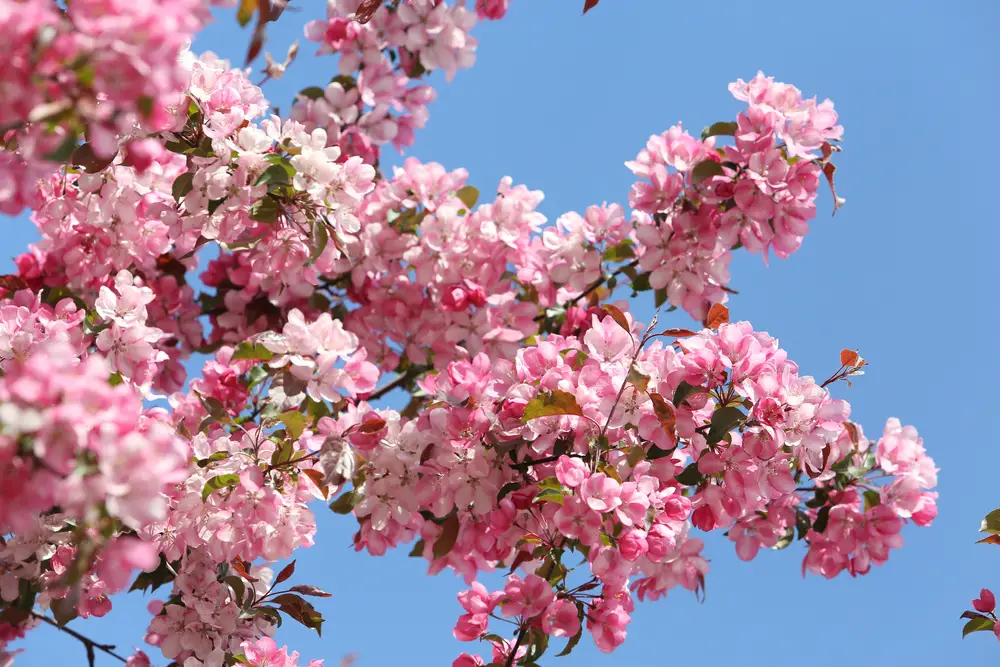Arkansas Plant Hardiness Zones
| USDA Hardiness Zone | Average Minimum Extreme Winter Temperature Range Fahrenheit (°F) Celsius (°C) | Average Last Frost Date Range In Spring (Beginning Of The Growing Season) | Average First Frost Date Range In Autumn (End Of The Growing Season) |
|---|---|---|---|
| 7a | 0°F to 5°F -17.8°C to -15°C | Mid to late April | Mid to late October |
| 7b | 5°F to 10°F -15°C to -12.2°C | Early to mid-April | Late October |
| 8a | 10°F to 15°F -12.2°C to -9.4°C | Early April | Early November |
| 8b | 15°F to 20°F -9.4°C to -6.7°C | Late March to early April | Early to mid-November |
Arkansas Growing Conditions

Credit to Wikipedia
General Climate
Arkansas has a humid subtropical climate.
Though it is an inland state, it is close enough to the Gulf of Mexico for it to significantly affect its climate. The Ozark Mountains, located in the northwestern part of the state, also play a big role in this way.
When warm, humid air from the Gulf of Mexico meets the cold, drier mountain air, it lifts and creates storms.
Arkansas has a four-season climate with hot and humid summers and mild to cool winters. It receives around 50 inches (127 centimeters) of precipitation each year (the national average is approximately 28.5).
The driest region in the state is in the Ozark Mountains, and the wettest is in the southeastern part of the state, in the Ouachita Mountains.
Microclimates
USDA plant hardiness zones are an important starting point for your garden, but you’ll also need to consider microclimates.
Microclimates are areas where specific conditions create a climate different from the climate they’re situated in.
Buildings, fences, paved areas, or short hills and valleys can create these microclimates.
They can be as small as a space in your backyard or as large as a city.
In other words, learn about your local conditions from local experts to see if your garden falls into a microclimate.
Extreme Weather
Tornadoes
Tornadoes are most destructive when the funnel clouds become long enough to touch the ground.
They can be one of the most damaging weather events.
While tornadoes can occur in Arkansas at any time of year, most activity occurs between March and May and November and January.
Tornadoes in Arkansas tend to move from southwest to northeast.
Beyond general storm preparation around your home, there is little you can do to protect your garden from tornadoes.
Ice Storms
An ice storm is a winter storm with freezing rain that builds on exposed surfaces to a thickness of at least ¼ of an inch.
The result is extremely slippery roads and walkways. The ice is also very heavy and can cause tree branches, powerlines, and even roofs to break under their weight.
Ice storms present serious hazards. Unfortunately, beyond general storm preparation, you cannot do much to protect your garden from them.
If your trees and shrubs sustain damage due to ice storms, the best thing you can do is prune away broken branches.
Thunderstorms
Thunderstorms often distribute large amounts of precipitation in Arkansas’ warmer months, potentially resulting in flooding.
Flooding can create several problems in your garden, including:
- Potential structural damage to beds and containers
- Soil erosion
- Plant damage
Additionally, flooding can bring contaminated water into contact with your plants. If it does, remove those plants, especially if they’re edible.
Growing Season
Arkansas’s growing season is long and runs from late March to mid-November (depending on the region).
Gardening in Arkansas takes a bit of planning around when to plant different crops. Some vegetables require a cool growing season and need to be planted early enough to be harvested before the heat of summer peaks. Other plants need longer periods of time and heat to reach maturity.
Developing a seeding schedule that ensures each variety you want to grow has enough time to mature within your area’s expected temperatures and conditions can be very helpful.
Arkansas Gardening Tips

Choose The Right Plants
Choose native plants for your garden. Doing so improves your chances of successfully growing them. They’ll be better adapted to your area’s local conditions and challenges.
Manage Water
Gardeners in most parts of Arkansas receive ample precipitation, though, in recent years, the state has also experienced drought conditions.
As such, you’ll need to adapt to current conditions to ensure your plants receive the right amount of water.
To mitigate the potential of too much water, ensure adequate drainage in your garden. This may be filling in low spots to strengthen sloping and natural runoff courses. This could also be capturing water and incorporating a rain garden.
In drier seasons, we recommend you:
- Use a layer of mulch around plants to retain water
- Water deeply once a week to encourage deep root growth in plants
- Water in the morning or evening to reduce evaporation
Pest and Disease Management
Due to high precipitation levels across most of the state, you are advised to manage disease and pest problems that may arise due to excessive moisture.
This can include:
- Using mulch at the base of plants to prevent splash up from soil and transmission of soil-borne fungal pathogens
- Ensuring plants have adequate spacing to allow good airflow
- Choosing to transplant instead of direct sowing because transplants will withstand some predatory eating from slugs or cutworms and the like
- Selecting local and disease-resistant varieties
- Practicing good garden hygiene and removing decaying vegetation to avoid providing a habitat for destructive insects
Consult With Local Professionals
Consulting with local gardening professionals allows you to benefit from their experience with your area’s conditions, the plants that do well there, and overall best practices.
Arkansas Plant Suggestions

Trees
- Loblolly Pine (Pinus taeda)
- White Oak (Quercus shumardii)
- Southern Magnolia (Magnolia grandiflora)
Shrubs
- Ozark Mock Orange (Philadelphus pubescens)
- Two-wing Silverbell (Halesia diptera)
- Deerberry (Vaccinium stamineum)
Flowers
- Apple Blossom (Pyrus coronaria)
- Hooked Buttercup (Ranunculus recurvatus)
- Blue-waterleaf (Hydrolea ovata)
Vegetables
- Bradley Pink Tomatoes (Lycopersicon esculentum “Bradley”)
- Sweet Potatoes (Ipomoea batatas)
- Zucchini (Curcubita pepo)
Herbs
- Goldenseal (Hydrastis canadensis)
- Chamomile (Matricaria chamomilla)
- Chives (Allium schoenoprasum)
Spices
- Caraway (Carum carvi)
- Anise seed (Pimpinella anisum)
- Carolina Allspice (Calycanthus floridus)
Note on the last one: The bark is dehydrated, ground and used as a cinnamon replacement. However, there is some evidence the flower and seeds are toxic to humans.29, 30
Fruits
- Persimmons (Diospyros virginiana)
- Jujubes (Ziziphus ziziphus)
- Pawpaws (Asimina triloba)
Succulents
- Nuttall’s Stonecrop (Sedum nuttallii)
- Widow’s Cross (Sedum pulchellum)
- Woodland Stonecrop (Sedum ternatum)
Disclaimer
Any of the above can change and is not exhaustive.
Treat anything above like a good starter guide. Then use that as a foundation as you consult with local gardeners, professionals, forecasts, guides, and organizations.

